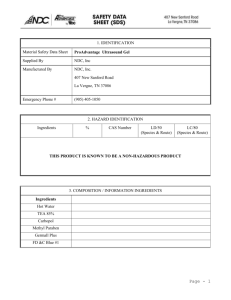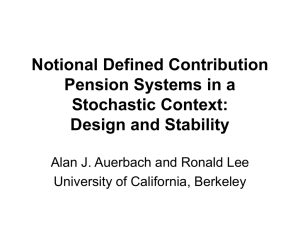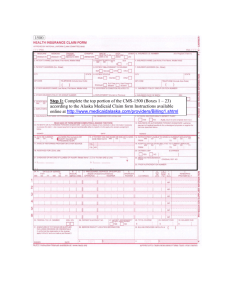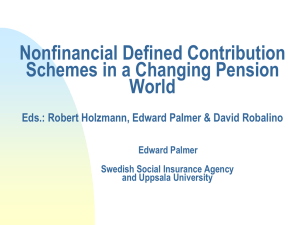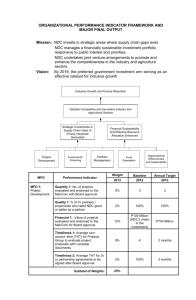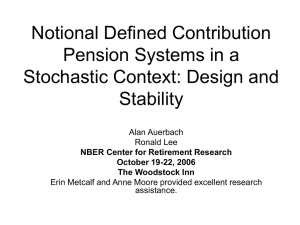Document
advertisement
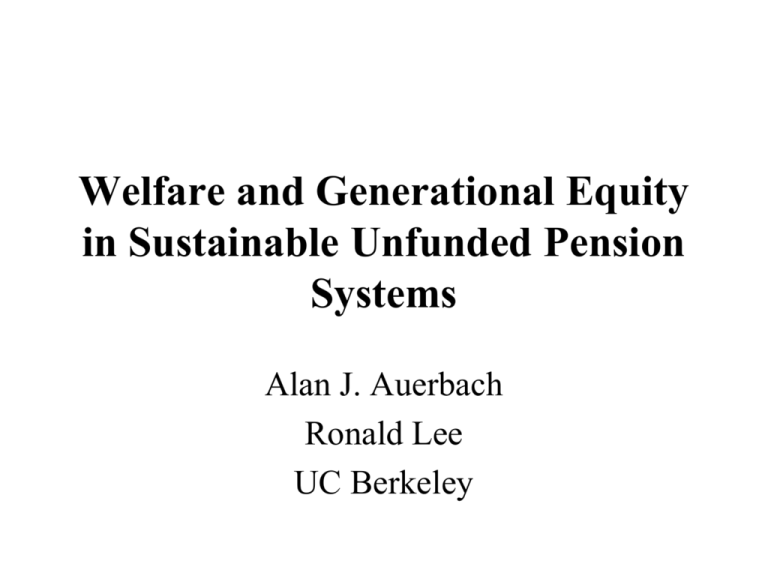
Welfare and Generational Equity in Sustainable Unfunded Pension Systems Alan J. Auerbach Ronald Lee UC Berkeley Overview • Need to reform existing PAYGO public pension schemes, due to lack of stability and transparency • Shift to funded systems confronts economic and political problems of transition • An alternative: Notional Defined Contribution (NDC) plans; PAYGO systems, but with some potential advantages (transparency, stability) NDC Systems • Two phases: accumulation and retirement • Accumulation phase – accumulate an imaginary stock of Notional Pension Wealth (NPW) based on annual contributions • Retirement phase: annuitize NPW using same assumed rate of return, based on life table NDC Systems • How is assumed rate of return determined? • This is the key decision with respect to potential stability • Sweden bases return on wage growth (g) adjusted for annual mortality probability • Could base return on growth of covered wages (n+g) Previous Auerbach-Lee Paper • Studied the Swedish NDC plan, in terms of stability • With stochastic wages, interest rates, birth rates and mortality (based on US data), how likely is debt to explode over time? • Swedish system is stable downward (no excessive debt build-up), but only because it also includes a “balancing mechanism” that reduces rate of return when trouble near; but doesn’t avoid asset accumulation Previous Auerbach-Lee Paper • Could avoid accumulation of assets (and pay a higher average rate of return) by making balance mechanism symmetric, also raising growth rate of accounts and benefits when system assets too high • Could make Swedish system more stable by basing growth rate of accounts and annuities on growth rate of wage bill (n+g) rather than growth rate of wage rate (g) This Paper • Look at risk-sharing and welfare properties of different types of fiscally stable systems – Actual Swedish system and symmetric variants of it from our earlier paper – New German system – Versions of the US system forced to be stable by annual tax or benefit adjustments The Systems • All systems based on simplified US OASI system for a representative individual per cohort – 10.6 percent payroll tax – work until age 67, with retirement at 67 • US system variants, all PAYGO, with tax profiles based on US data, and benefit profiles generated by simplified version of benefit formula assuming retirement at 67 The Systems • Three US system variants: – “Benefit Adjust” – raise or lower benefits each year so that taxes = benefits – “Tax Adjust” – raise or lower taxes each year so that taxes = benefits; scale so that average tax rate = 10.6 percent (since actual US system not viable) – “50-50 Adjust” – divide annual adjustment equally between taxes and benefits The Systems • Swedish system variants: – All with tax rate fixed at 10.6 percent – Actual Swedish system • Notional Pension Wealth accumulates at rate g and is annuitized at age 67, with annuity rate of return also based on g • Brake mechanism that temporarily lowers benefits by setting gross return to (1+g)b when a measure of assets/liabilities, b, falls below 1 The Systems • Three Swedish system variants: – All with symmetric brake – Two based on g, one based on n+g – One with full brake, reducing gross rate of return by a factor (1- b); two with dampened brake, reducing gross rate of return by a factor 0.5*(1-b) The Systems • German system: – Strictly PAYGO – Benefits the same for all cohorts at a given time – Benefits grow according to: OAt 1 OAt 2 AGWt 1 (1 CRt 1 ) Bt Bt 1 * * 1 * AGWt 2 (1 CRt 2 ) OAt 2 – Taxes adjusted as a residual to ensure balance – System scaled so that taxes average 10.6 percent Evaluation Criteria • Internal Rate of Return (IRR) • Net Present Value relative to PV of earnings (NPV) • Expected Utility Approximation (EU) • Horizontal Equity (HE) • Social Welfare Function, taking transition generations into account (SWF) Social Welfare Measures US Tax Adjust US – Ben. Adjust US – NDC NDC 50-50 Sweden (g) Adjust Symm. Brake A=.5 NDC (g) Symm. Brake A=1 NDC German (n+g) Symm. Brake A=.5 Unadjusted =0 0.00140 0.00140 0.00140 -0.00878 0.00189 0.00186 0.00181 0.00140 Adjusted =0 0.00186 0.00186 0.00186 -0.00878 0.00186 0.00186 0.00186 0.00186 =3 -0.00360 -0.00262 -0.00227 -0.01175 -0.00229 -0.00226 -0.00248 -0.00241 =5 -0.02063 -0.01877 -0.01844 -0.02645 -0.01796 -0.01788 -0.01835 -0.01875 Social Welfare Measures US Tax Adjust US – Ben. Adjust US – NDC NDC 50-50 Sweden (g) Adjust Symm. Brake A=.5 NDC (g) Symm. Brake A=1 NDC German (n+g) Symm. Brake A=.5 Unadjusted =0 0.00140 0.00140 0.00140 -0.00878 0.00189 0.00186 0.00181 0.00140 Adjusted =0 0.00186 0.00186 0.00186 -0.00878 0.00186 0.00186 0.00186 0.00186 =3 -0.00360 -0.00262 -0.00227 -0.01175 -0.00229 -0.00226 -0.00248 -0.00241 =5 -0.02063 -0.01877 -0.01844 -0.02645 -0.01796 -0.01788 -0.01835 -0.01875 Social Welfare Measures US Tax Adjust US – Ben. Adjust US – NDC NDC 50-50 Sweden (g) Adjust Symm. Brake A=.5 NDC (g) Symm. Brake A=1 NDC German (n+g) Symm. Brake A=.5 Unadjusted =0 0.00140 0.00140 0.00140 -0.00878 0.00189 0.00186 0.00181 0.00140 Adjusted =0 0.00186 0.00186 0.00186 -0.00878 0.00186 0.00186 0.00186 0.00186 =3 -0.00360 -0.00262 -0.00227 -0.01175 -0.00229 -0.00226 -0.00248 -0.00241 =5 -0.02063 -0.01877 -0.01844 -0.02645 -0.01796 -0.01788 -0.01835 -0.01875 Social Welfare Measures US Tax Adjust US – Ben. Adjust US – NDC NDC 50-50 Sweden (g) Adjust Symm. Brake A=.5 NDC (g) Symm. Brake A=1 NDC German (n+g) Symm. Brake A=.5 Unadjusted =0 0.00140 0.00140 0.00140 -0.00878 0.00189 0.00186 0.00181 0.00140 Adjusted =0 0.00186 0.00186 0.00186 -0.00878 0.00186 0.00186 0.00186 0.00186 =3 -0.00360 -0.00262 -0.00227 -0.01175 -0.00229 -0.00226 -0.00248 -0.00241 =5 -0.02063 -0.01877 -0.01844 -0.02645 -0.01796 -0.01788 -0.01835 -0.01875 Conclusions • Swedish system provides most stability, but generally not as good as other systems under welfare measures – This is particularly so when transition is taken into account, because the stability is provided by a buffer stock accumulated at the expense of early generations • Basing NDC plan on g rather than n+g may be better for welfare, even if not for stability – Smaller fluctuations when brake is not in effects seem to outweigh more frequent application of the brake (with associated fluctuations) • Systems that spread risk broadly over generations (US 50-50, NDC) do best
